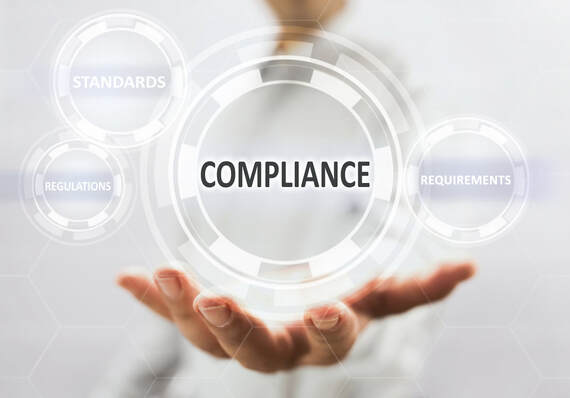|
Maintaining compliance with IT requirements is essential for any business, large or small. In order to ensure the safety and security of your data, as well as that of your customers, it is important to have a comprehensive understanding of the relevant compliance regulations and to implement the necessary safeguards. This article provides an overview of some of the key compliance requirements for businesses across many industries, including healthcare, manufacturing, retail, professional services and small business.
Too often businesses choose to ignore or take shortcuts when it comes to IT compliance, underestimating the risks and potential costs. In reality, failing to comply with IT requirements can result in serious financial and legal consequences, including fines, lawsuits and even criminal charges. The bottom line is that achieving and maintaining compliance is essential for any business, and it's not worth taking chances with your data or reputation. Let's talk about your level of compliance, and your company's adherence to legally binding agreements made by your company representatives and the impact on IT systems and security. Your organization's compliance posture is the result of decisions made about which laws, regulations, and contracts to comply with, and how well your company adheres to these requirements. To avoid penalties and legal action, you need to ensure that you are aware of all the compliance risks associated with your business operations and have put in place appropriate controls to mitigate these risks. There are a number of benefits to achieving and maintaining compliance with IT requirements, including:
What is IT compliance? IT compliance refers to the set of policies and procedures that an organization must follow in order to ensure that its information technology (IT) systems are secure and compliant with all relevant laws and regulations. Internal IT compliance, for example, focuses on establishing rules across a company's organizational structure to safeguard data. External corporate compliance regulations, on the other hand, focus on client satisfaction and the protection of customers' personal information. Compliance is maintained using digital technology to identify, monitor, audit, and report standards adherence. In order to meet regulatory compliance standards, your organization's policies and procedures must support these essential IT system goals:
IT compliance is important for a number of reasons. First, it helps to ensure the security of an organization's IT systems. This is critical in today's world, as data breaches can lead to serious financial and reputational damage. Additionally, IT compliance can help to prevent legal problems, as failure to comply with relevant laws and regulations can result in significant fines and penalties. Finally, IT compliance can improve organizational efficiency by establishing clear rules and procedures for employees to follow. When it comes to IT compliance, there are a number of different frameworks that organizations can choose to follow. The most common include the International Organization for Standardization's (ISO) 27001 standard, and the National Institute of Standards and Technology's (NIST) Cybersecurity Framework. It is important to note that compliance is not a one-time event; rather, it is a continuous process that should be revisited on a regular basis. This is because the IT landscape is constantly changing, and new compliance requirements are always being introduced. There are a number of high-profile examples where businesses have suffered significant consequences as a result of ignoring their compliance requirements. One of the most well-known is the Target data breach, which occurred in 2013. In that case, hackers were able to gain access to the retailer's computer systems and steal credit card information belonging to millions of customers. As a result of the breach, Target was forced to pay out millions of dollars in damages to affected customers. Another high-profile example of a business ignoring their IT compliance requirements is the Ashley Madison data breach. In that case, hackers were able to gain access to the website's user database and steal personal information belonging to millions of customers. As a result of the breach, Ashley Madison was forced to pay out millions of dollars in damages to affected customers. Organizations that fail to comply with their IT compliance requirements can also face significant legal penalties. For example, in 2018, the European Union fined Google $5.1 billion for violating its antitrust laws. This was the largest fine ever imposed by the EU on a single company. Similarly, in 2017, credit reporting agency Equifax was fined $700 million by the U.S. Federal Trade Commission for failing to properly protect the personal information of millions of customers. As these examples illustrate, IT compliance is a critical issue that all organizations must take seriously. Failing to comply with relevant laws and regulations can have serious consequences, including financial penalties, damage to reputation, and loss of customer trust. What are some common IT compliance requirements? There are a number of common IT compliance requirements that organizations must meet. These include requirements related to data security, data backup, and disaster recovery. Many jurisdictions have specific requirements for businesses that handle personal data, such as the European Union's General Data Protection Regulation (GDPR). Here are six of the top IT compliance areas that may pertain to your business: 1. Telephone Consumer Protection Act (TCPA): The Telephone Consumer Protection Act (TCPA) is a law that sets rules for how businesses can contact customers using telephone calls, text messages, and faxes. 2. Health Insurance Portability and Accountability Act (HIPAA): The Health Insurance Portability and Accountability Act (HIPAA) is a law that sets rules for how businesses can handle the personal information of patients. 3. Payment Card Industry Data Security Standard (PCI DSS): The Payment Card Industry Data Security Standard (PCI DSS) is a set of security requirements for businesses that process credit card payments. 4. Sarbanes-Oxley Act (SOX): The Sarbanes-Oxley Act (SOX) is a law that sets rules for how businesses must protect financial information. 5. Federal Information Security Management Act (FISMA): The Federal Information Security Management Act (FISMA) is a law that requires federal agencies to implement risk management practices to protect their information systems. 6. General Data Protection Regulation (GDPR): The General Data Protection Regulation (GDPR) is a new data protection law that applies to businesses operating in the European Union. How to achieve IT compliance? There is no one-size-fits-all answer to this question, as the best way to achieve IT compliance will vary depending on the specific requirements of your organization. However, there are a few general tips that can help you get started:
There are a number of steps that organizations can take to ensure IT compliance. First, they should develop a comprehensive set of policies and procedures related to IT security and management. Additionally, they should put in place technical controls mentioned above, such as appropriate firewalls and intrusion detection systems, to help protect their systems from attack. Finally, they should provide regular training for employees on how to comply with the organization's IT policies and procedures, especially cybersecurity and compliance. What are the challenges of achieving and maintaining IT compliance? The challenges of achieving and maintaining IT compliance can be significant, as it can be difficult to ensure that all relevant controls are in place and functioning properly. Many organizations find it difficult to balance the need for compliance with the need for innovation and flexibility. There are several challenges associated with achieving and maintaining IT compliance, including: - The cost of compliance: Implementing compliant IT systems and processes can be costly for organizations. - The complexity of compliance: There are a large number of laws, regulations, and industry standards that organizations must comply with. This can make it difficult for organizations to keep track of all the requirements. - The changing landscape: The landscape of compliance is constantly changing as new laws and regulations are enacted. This can make it difficult for organizations to stay up-to-date on the latest requirements. Thank you for reading this article! f you are looking for assistance with IT compliance, please contact us today. We are experts in helping businesses to meet a wide range of compliance requirements, including those relating to data security, privacy, HIPAA, PCI DSS and more. Our team can provide you with the guidance and support you need to ensure that your business meets all its compliance obligations. We hope it has been helpful in providing an overview of the importance of achieving and maintaining IT compliance for your business. For more information about our compliance services, please contact us today at 508-528-7720. Thank you. |
AuthorOur blog posts are written by several members of our team. Please contact us if a particular post or topic is of further interest. We're here to help keep your business up and running. Archives
December 2023
Categories |
Services |
|
CTS Services, Inc. 260 Maple Street, Bellingham, MA 02019 Phone 508-528-7720 Fax: 508-966-9734


 RSS Feed
RSS Feed
